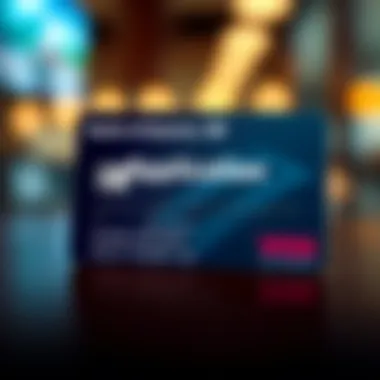Navigating the Bank of America Credit Card Review Process


Intro
The journey of applying for a credit card with Bank of America can be a bit like navigating a maze. You submit your application, and then you're left waiting for a decision. This period of uncertainty, often labeled as "application in review," raises questions that many applicants have. Understanding how to interpret this phase is crucial. It not only impacts your financial planning but also influences future transactions.
While some applicants may breeze through to approval, others find themselves stuck in limbo. Factors influencing this include your credit history, the completeness of your application, and, occasionally, internal checks that Bank of America conducts. Knowing what to expect can take the edge off this often anxious time.
In this piece, we will illuminate the various aspects of the Bank of America credit card application review process. We’ll cover timelines, essential steps to navigate the waiting game, and specific strategies to employ if your application is pending for an extended time. By the end of this article, you’ll emerge not just informed, but empowered to handle your credit card application more effectively.
Prelude to Credit Card Applications
The world of credit cards is an intricate landscape that plays a crucial role in personal finance. Understanding the credit card application process, especially with a major institution like Bank of America, is essential for anyone looking to improve their financial footing. In this discussion, we dig into key elements that make the application process significant, offering insights and considerations that could make or break an applicant's chance of success.
Understanding Credit Card Applications
Credit card applications are not merely pieces of paper or digital forms; they are gateways to financial opportunities. Each application is an individual's chance to establish or enhance their credit history, which can subsequently affect their ability to secure loans, mortgages, or even good insurance rates. When you submit an application, you’re not just filling out a form, but setting the stage for your financial future.
The application process involves sharing personal information such as income, employment details, and credit history. But to make a successful application, one must comprehend what is on the line. Many applicants overlook aspects that can be pivotal, like how their credit score impacts approval odds or even the types of cards they may be eligible for. For instance, someone with a stellar credit score may not need to stress over getting approved for a premium rewards card, whereas a lower score might confine them to basic offerings. Understanding which card suits your financial reality is key to a successful application.
Importance of Status Updates
After submitting an application, applicants often find themselves in limbo, eagerly awaiting news on their status. This is where the importance of status updates comes into play. Knowing where your application stands is more than just a matter of curiosity; it can influence financial plans and spending behavior.
Being kept in the dark about your application status could lead to unnecessary anxiety, but timely updates can provide a level of assurance. Financial stability doesn’t just rest on being approved for a credit card; it often expands into how one manages their finances thereafter. A clear understanding and regular updates about your application can also reveal if additional documentation is required, or if there are underlying issues that need to be addressed. For instance, if an application is stuck in review due to income verification complications, being proactive can help resolve matters quicker.
In summary, the credit card application process is much more than a bureaucratic hurdle; it’s an essential step in building one’s financial future. Being knowledgeable and proactive can make a significant difference in how applicants navigate through it. By understanding the mechanics behind applications and the importance of keeping track of status updates, individuals can empower themselves on their financial journey.
The Bank of America Application Process
Understanding the application process for a credit card with Bank of America is essential for any applicant hoping to manage their finances effectively. This bank, renowned for its extensive range of financial products, has established a systematic approach for processing credit card applications. Knowing the ins and outs of this application process can provide clarity, alleviate anxiety, and help individuals make informed decisions regarding their financial future.
The Bank of America application process comprises a variety of steps designed to assess each applicant's creditworthiness. This not only ensures that the bank maintains its lending standards but also aids applicants in presenting the strongest case possible when applying for a credit card. Some specific elements to consider include the types of financial profiles the bank looks for, the required documentation, and the responsive environment that actualizes a seamless application experience.
Step-by-Step Application Procedure
When applying for a credit card through Bank of America, following a structured process can make a world of difference. Here's an organized breakdown of the steps you should expect:
- Choose Your Credit Card: Bank of America offers a plethora of credit card options, each catering to different needs—whether you're aiming to earn rewards, save on interest, or build your credit.
- Gather Necessary Information: Applicants should compile critical information, such as Social Security Number, employment details, income level, and other relevant financial information. Getting your ducks in a row can speed up the application process significantly.
- Complete the Online Application: Visit the official Bank of America website and navigate to the credit card section. Fill out the application with accurate and precise information.
- Submit the Application: After reviewing your entries, submit your application. The system might confirm receipt almost immediately, providing an initial sense of assurance.
- Application Review Period: The application will then enter review. During this time, Bank of America will scrutinize your credit profile along with your submitted documents to make an informed decision.
- Receive Your Decision: After the review, applicants will either receive an approval, conditional approval, or denial message via email or through their online banking account.
Types of Credit Cards Offered
Bank of America provides an impressive variety of credit cards, allowing potential cardholders to select a product that aligns with their individual financial objectives. Here are some noteworthy categories:
- Cash Rewards Credit Cards: Aimed at those who prefer earning cash back on purchases. This can be a great way to get rewards for everyday spending.
- Travel Rewards Credit Cards: These cards are designed for travelers. They often offer points that can be redeemed for flights, hotel stays, and other travel-related expenses.
- Balance Transfer Cards: Ideal for individuals looking to minimize existing credit card debt with lower interest rates on transferred balances.
- Secured Credit Cards: An option for those new to credit or those looking to rebuild their credit history. These cards require a security deposit, which serves as your credit limit.
"Choosing the right credit card can have long-term implications for your financial health, so take the time to find one that aligns with your lifestyle."
By understanding these different offerings and the application process, applicants can approach the Bank of America credit card application with a well-informed mindset, significantly enhancing their chances of achieving the desired outcome.
What Does 'Application in Review' Mean?
Understanding the phase of 'application in review' is pivotal for anyone who has applied for a credit card, especially with Bank of America. This stage is not just a mere waiting game; it carries significant implications for your credit journey. Being in review essentially indicates that the lender is scrutinizing your application across various metrics to make an informed decision.
Defining the Review Status
When an application status reads as 'in review', it means that the financial institution, in this case, Bank of America, is assessing numerous aspects of your application. This can include analyzing your credit score, evaluating your employment history, and considering your debt-to-income ratio. It's a thorough process, ensuring that the bank can assess the risk involved in extending credit to you.


This review can take time, and during this period, the bank may reach out for additional documentation or clarification. Understanding this definition is crucial because it sets the expectation that not all credit decisions are instantaneous. Many applicants mistakenly think that a delay indicates a negative outcome, when in fact, it often means that careful consideration is being given to your financial situation.
Why Applications Enter This Status
Several reasons contribute to an application being marked as 'in review'. Often, it relates to the complexity or the amount of information provided in your application. If the details are incomplete or if any red flags are raised during the initial scans, your application will likely enter this review phase. Here are some key factors that may trigger this status:
- Discrepancies in Information: If there are mismatches between the personal information you provided and what the bank can verify, they will want to clear this up before making a decision.
- Credit Profile Complexity: If your credit history is extensive or involves unusual transactions, it could lead the lender to take extra time to analyze your profile.
- New Accounts or Inquiries: Recently opened accounts or numerous credit inquiries may prompt a deeper look into your credit behavior.
Many applicants feel a sense of frustration during this period, but it’s worth noting that the 'in review' phase ultimately aims to protect both the applicant’s and the bank’s interests. It's a necessary process that reflects responsible lending practices. Remember, patience is key during these times; rushing for a decision isn't always in your best interest.
Factors Influencing Application Review
The application review process at Bank of America isn't merely a matter of boxes being checked off. In fact, the evaluation hinges on a confluence of several factors, each carrying its weight in determining whether an application moves forward or remains in limbo. Understanding these elements can demystify what might feel like a black box for many applicants. Let's explore the core aspects that play a pivotal role in this review.
Credit Profile Analysis
Firstly, an individual's credit profile is the cornerstone of the review process. This profile encompasses various financial behaviors, including payment history, credit utilization rate, and the age of credit accounts.
- Payment History: If you've consistently paid bills on time, you'll likely afford a more favorable review. Late payments can raise red flags.
- Credit Utilization: Aim to keep this ratio below 30%. Higher utilization may suggest you rely heavily on credit, which could signal a risk to creditors.
- Credit Age: A long history generally works in favor of applicants. Older accounts show lenders how responsibly you’ve managed credit over time.
Having this insight can make it clear why it often pays to check your credit score before applying. Being aware of your standing allows you to strategize and improve if necessary.
Income Verification Procedures
Next up is income verification, a crucial piece of the puzzle. Bank of America needs to confirm that applicants have a stable source of income that aligns with their requested credit limits. Here’s what that generally involves:
- Documentation: Be prepared to provide recent pay stubs, tax returns, or employment verification letters.
- Debt-to-Income Ratio: This ratio reflects your monthly debt payments compared to your gross monthly income. A lower ratio paints a clear picture of your financial health.
- Total Assets: Details regarding savings or checking account balances can also play a role. A robust financial footing can tip the scales in your favor.
In essence, a well-documented and transparent income statement can strengthen your case for credit approval, reflecting responsible financial management.
Existing Relationship with Bank of America
Last but not least is the existing relationship you maintain with Bank of America. This aspect can significantly influence the outcome of your application. Here are some ways this relationship can matter:
- Account History: If you’ve been a customer for years, having a history of holding accounts like checking, savings, or previous credit products often works to your advantage.
- Account Behavior: Regular deposits and maintaining positive balances matter. Frequent overdrafts or missed payments on any existing accounts can tarnish your standing.
- Loyalty Perks: Loyal customers may have easier access to credit products. Bank of America might be inclined to favor existing customers, especially if they demonstrate responsible behavior.
Having a solid foundation of a banking relationship can mean the difference between gaining access to credit or facing an unexpected setback.
The intersection of credit profile, income verification, and banking relationships forms the bedrock of the application review process, providing crucial touchstones for Bank of America as they evaluate prospective applicants.
Timeline for Application Review
Understanding the timeline for your Bank of America credit card application review is crucial for any applicant. This phase can feel like a black hole, where time seems to stretch indefinitely, but having a sense of what to expect can ease some of that anxiety. Key elements include the typical durations for each review phase, common causes for delays, and how these factors impact your overall application experience.
Typical Duration of Review Phases
When you submit an application for a credit card, it's essential to know how long you'll be left waiting. Generally speaking, most applications enter an initial review phase, which can last anywhere from a few minutes to several days. More specifically:
- Instant Approval: For straightforward applications where the credit profile aligns well with the card's requirements, you might receive approval immediately.
- Standard Review: If the application requires further scrutiny, expect the review to take 3 to 10 business days. This is quite standard, and it's not uncommon for applicants to check back after a week or so.
- Extended Review: In some situations, the review can drag on for up to 30 days. This often happens when the bank needs more documentation or when there are any discrepancies in your application. It's worth noting that a longer wait doesn't inherently mean your application is in trouble.
What Delays May Occur?
While you might be eager to receive word on your application, several factors can cause delays during the review process. Understanding these can help you manage your expectations:
- Incomplete Information: If you left out any crucial details in your application, it can result in a hold-up while the bank seeks clarification or additional paperwork from you.
- High Volume of Applications: At certain times of the year, such as back-to-school or holiday seasons, banks may experience a surge in application volume, leading to longer processing times.
- Credit History Issues: Any red flags on your credit report, such as missing payments or recent inquiries, could trigger a more thorough investigation.
- Income Verification: If Bank of America wishes to substantiate your stated income, they might contact you for additional documentation, which adds time to the process.
In summary, being aware of the timeline and potential delays can help keep your stress levels in check while waiting for your credit card application status. By knowing what could happen, you can prepare yourself for each potential outcome.


What Happens After the Review?
The moment you hit 'submit' on your Bank of America credit card application, the journey enters a crucial phase. Understanding what happens after the review can provide clarity during what can sometimes feel like an uncertain wait. Knowing the possible outcomes and how to act upon them can save you headaches down the line.
The outcome of your application can dictate not just your immediate access to credit but also your long-term relationship with the bank. This section focuses on the potential results of the review and how you, as an applicant, can effectively navigate the next steps presented by those outcomes.
Possible Outcomes of the Review Process
Once your application has undergone the review, a few different scenarios can unfold:
- Approval: This is, of course, what every applicant hopes for. If your application is approved, you'll receive the terms of your card, and it's just a matter of time before the card arrives.
- Denial: Unfortunately, not all applications end in approval. A decline can stem from various factors, including credit score, existing debt levels, or insufficient income.
- Further Review: Your application may be flagged for additional review. This can occur for a range of reasons, from needing more information regarding your credit history to a potential clash in automated underwriting systems.
- Conditional Approval: Sometimes, the bank may approve your application under certain conditions, such as requiring a higher initial deposit or having a co-signer.
Each possible outcome carries its own implications. Obviously, approvals come with the benefits of increased purchasing power, but denials can often be challenged or re-evaluated, allowing for improvements over time.
How to Proceed with Different Outcomes
Understanding how to respond to each outcome effectively is vital to keeping your financial goals on track:
- If Approved:
- If Denied:
- If Further Review:
- If Conditionally Approved:
- Review Terms: Take a closer look at your card's annual fee, interest rates, and any potential rewards programs.
- Set Up Account Online: Ensure you set up online banking for easier management of your card transactions, payments, and billing cycles.
- Request a Reason: Often, a denial letter will outline why your application was not accepted. This is an invaluable resource for future applications.
- Improve Your Profile: Take note of the issues highlighted in the denial. These could include strengthening your credit score or reducing outstanding debts. You may want to obtain a copy of your credit report to review your history comprehensively.
- Contact Customer Service: A short, polite inquiry can often yield answers. Ask what further information is needed, and be ready to provide any documentation they might request.
- Exercise Patience: Recognize that additional reviews can take longer. Doing so will help maintain your peace of mind.
- Evaluate Conditions Closely: Make sure the requirements fit within your financial capabilities. Sometimes, opting for a different card may be more beneficial in the long run.
Regardless of the outcome, proactive communication with Bank of America can be your best ally. Keeping a finger on the pulse of your application status ensures you're equipped with the knowledge needed to take meaningful next steps. Remember that the review process isn't just an endpoint; it’s part of a broader journey toward smart financial decisions.
Applicant Communication Strategies
Effective communication plays a critical role in navigating the complexities of the credit card application process. This is especially true when dealing with a major institution like Bank of America. Understanding how to engage with the bank can significantly impact your experience and potentially the outcome of your application.
Effective Inquiry Techniques
When your application status is stuck in limbo, it’s crucial to reach out and inquire about your application’s progress. Here are some strategies to keep in mind:
- Be Direct but Polite: When reaching out, clearly state that you wish to inquire about the status of your application. A simple phrase like, "I am following up on my credit card application dated [insert date]" can do wonders.
- Utilize Multiple Channels: Don’t limit your inquiry to just one medium. Consider calling customer service, sending an email, or even using social media platforms. Each channel may yield different responses.
- Stay Persistent but Patient: If you don’t receive a response right away, don’t hesitate to follow up. Just be sure to allow for a reasonable amount of time before doing so – often a week is fair.
"The squeaky wheel gets the grease, but timing is everything."
What Information to Have Ready
Before reaching out, you should prepare certain key pieces of information to facilitate a smoother communication experience:
- Personal Identification Information: Have your full name, Social Security number, and any identification number associated with your application on hand. This will help the customer service representative locate your account quickly.
- Application Details: Make note of the date you submitted your application and any reference or confirmation numbers if you received them. This information will streamline the inquiry process.
- Specific Questions: Prepare a list of concise questions you might want to ask. This could include inquiries about the reason for the review status or potential timeframes for a decision.
By ensuring you have this information ready, you can make your inquiry effective and focused, ultimately increasing the chances of receiving a satisfying response.
Resubmitting or Adjusting Applications
When navigating the murky waters of credit applications, especially with a major institution like Bank of America, one finds that the ability to resubmit or adjust applications can be of utmost importance. A credit card application, once submitted, might not always sail through the review process smoothly. Prospective applicants might find themselves in situations where they must reconsider their previous submissions. In this segment, we will delve into the specific elements surrounding resubmitting or adjusting applications, discussing the benefits and considerations that applicants should keep in mind.
When to Consider Resubmission


The decision to resubmit a credit card application is not one to be taken lightly. Several indicators can signal that it may be time to give another go. Here are a few considerations:
- Denial Reasons: If an applicant receives a denial, understanding the reasons behind it is crucial. Was it due to a poor credit score, lack of sufficient income, or insufficient credit history? Knowing the cause can inform whether a resubmission is warranted.
- Improved Financial Standing: If the applicant's financial situation has improved since the initial application—say, a new job with higher income or settling prior debts—this could strengthen the likelihood of approval.
- Changes in Credit Policy: Financial institutions often revise their credit policy strategies or card offerings. Staying informed about any new programs that might be a better fit can spark the decision to reapply.
- Waiting Period: It's wise to consider the timing. Some lenders may have a cooling-off period post-denial. Exhausting that waiting period is advisable before submitting a new application.
Revising Financial Information
Before hitting that resubmit button, revising financial information is somewhat like polishing a gemstone—incremental, yet impactful. Here’s what to consider:
- Accurate Income Reporting: Ensure that you're reporting your current income accurately. If you’ve received a raise or taken on additional work, be sure to reflect that in your application.
- Debt-to-Income Ratio: Re-evaluate your debt-to-income ratio. If it has improved—perhaps due to paying down debts or reducing expenses—this change should be highlighted in a new application.
- Credit Score Updates: Keep an eye on your credit score. If, after the initial application, your score has seen a marked improvement due to responsible credit behavior, consider including any reports or documents that could substantiate this enhancement.
- Mistakes and Clarifications: If there were any errors in the previous application, whether a misreported number or a missed out detail, rectify those mistakes before submitting again. Providing clear explanations for any past discrepancies can smooth the path toward approval.
Ultimately, being strategic in revising financial information while seeking to resubmit can significantly change the outcome.
"Success usually comes to those who are too busy to be looking for it." - Henry David Thoreau
In summary, although the application process can be frustratingly opaque at times, knowing when to adjust or resubmit your Bank of America credit card application—with a better understanding of your financial status—can be the key to unlocking new opportunities. For further information or guidance, resources such as NerdWallet and Experian can be invaluable for understanding personal finance and credit.
Following these steps can lead not merely to a successful application but also foster a sense of empowerment in managing one’s financial future.
Overcoming Application Frustrations
The credit card application process can sometimes feel like a never-ending saga. Especially when faced with uncertainties or delays, applicants may experience increased stress. Understanding how to handle these feelings is vital in the overall journey toward credit approval. Knowing how to overcome frustrations allows potential cardholders to maintain a level head, which can influence decisions down the line.
Navigating Delays and Uncertainty
Delays during the application review can send anyone into a tailspin. You submit all required information, and the waiting begins. That waiting period often feels like an eternity, making it crucial to know how to cope with the uncertainties that naturally arise.
When your application status shows 'in review,' it may help to remember that thorough assessments take time. Each detail is scrutinized, as card issuers want to ensure they make informed decisions about who they extend credit to. This process can take anywhere from a few minutes to several days. Factors like the complexity of your financial history or the volume of applications being processed can affect these timelines.
To navigate this period, consider engaging with your applicants' portal or contacting customer service for updates. Knowing where you stand goes a long way in easing anxiety. Using tools like the Bank of America mobile app can provide real-time updates on your application status. This can give you peace of mind by keeping you in the loop, letting you know you're not in limbo.
Tips for Maintaining Composure
Staying calm during the review process is paramount. Here are a few strategies to help you keep your cool:
- Breathe and Reflect: Take a step back and practice mindfulness. Focusing on your breathing can ease any anxiety about the wait. Remind yourself that reacting impulsively is rarely beneficial.
- Stay Informed: Knowledge is power. Read up on the application process to understand why things may be taking longer than expected. Knowing common timelines can help you set realistic expectations.
- Limit Comparisons: It's easy to look at friends or family members who might have gotten approved quickly. Everyone’s financial history is unique. Focus on your situation, rather than comparing with others.
- Engage Support: Talking to someone who has navigated the credit card space before can lend some perspective and even reveal new coping strategies.
By taking these steps to remain composed, you’ll position yourself for better decision-making throughout the credit application process. This means you won’t jump the gun and potentially create further complications for yourself.
"Patience is bitter, but its fruit is sweet." – French Proverb
In sum, overcoming application frustrations is about understanding the inherent delays and maintaining even keel attitudes while awaiting important decisions. Your ability to manage these frustrations can make your experience less stressful and ultimately lead to more favorable outcomes.
Finale and Final Thoughts
In this article, we examined the critical aspects of the Bank of America credit card application review process. The importance of understanding this process cannot be overstated. Knowing what happens during an application in review can significantly impact an applicant's approach and expectations. This extends from the initial application to dealing with potential outcomes post-review.
Understanding the timeline offers clarity, guiding applicants through what can sometimes feel like an endless wait. When equipped with the right knowledge, individuals can maintain their composure and strategize their next steps post-application. The advice on communication helps to demystify the sometimes opaque nature of financial institutions, enabling applicants to engage effectively. The nuances covered in this article have the potential to empower future applicants, shedding light on the strategies that may lead to favorable outcomes.
"Knowledge is power; understanding the credit application process gives you control over your financial journey."
Furthermore, it's important to recognize how various factors can influence the decision-making process. From your credit history to existing relationships with the institution, every little detail contributes to how your application is perceived. An informed applicant stands a better chance of navigating these complexities with ease and confidence.
Summarizing Key Takeaways
- Awareness of the Review Process: Recognizing what an 'application in review' means helps in managing expectations.
- Timeline Insights: Understanding the typical duration helps mitigate anxiety and allows for better planning.
- Communication Techniques: Mastering effective inquiry tactics ensures that you remain informed and proactive about your application.
- Response to Outcomes: Knowing the potential results of your application positions you to react thoughtfully, whether it’s accepting a credit card offer or addressing a denial.
Future Considerations for Applicants
As you step into the world of credit applications, remember these considerations:
- Regular Credit Monitoring: Keep an eye on your credit profile. Tools and platforms like Credit Karma or Experian can provide insights into your current status.
- Building a Relationship: If you frequently utilize Bank of America’s offerings, your established rapport can work in your favor during the review process.
- Preparedness for the Unexpected: While prepping for an application, it’s wise to anticipate any possible outcomes. Know how to handle a denial gracefully and how to pivot to a new application if necessary.
- Stay Informed on Policy Changes: Bank policies change over time. Keep abreast of any announcements regarding application requirements or eligibility which might impact your future attempts.
Stay adaptable and informed to navigate the credit landscape effectively.



